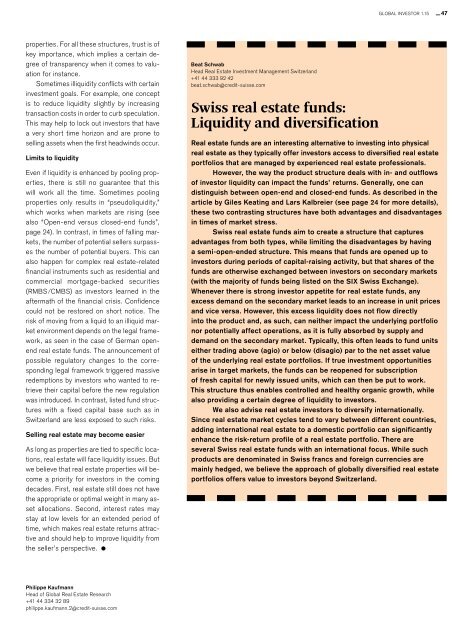Illiquid assets
Unwrapping alternative returns Global Investor, 01/2015 Credit Suisse
Unwrapping alternative returns
Global Investor, 01/2015
Credit Suisse
Create successful ePaper yourself
Turn your PDF publications into a flip-book with our unique Google optimized e-Paper software.
GLOBAL INVESTOR 1.15 — 47<br />
properties. For all these structures, trust is of<br />
key importance, which implies a certain degree<br />
of transparency when it comes to valuation<br />
for instance.<br />
Sometimes illiquidity conflicts with certain<br />
investment goals. For example, one concept<br />
is to reduce liquidity slightly by increasing<br />
transaction costs in order to curb speculation.<br />
This may help to lock out investors that have<br />
a very short time horizon and are prone to<br />
selling <strong>assets</strong> when the first headwinds occur.<br />
Limits to liquidity<br />
Even if liquidity is enhanced by pooling properties,<br />
there is still no guarantee that this<br />
will work all the time. Sometimes pooling<br />
properties only results in “pseudoliquidity,”<br />
which works when markets are rising (see<br />
also “Open-end versus closed-end funds”,<br />
page 24). In contrast, in times of falling markets,<br />
the number of potential sellers surpasses<br />
the number of potential buyers. This can<br />
also happen for complex real estate-related<br />
financial instruments such as residential and<br />
commercial mortgage-backed securities<br />
(RMBS /CMBS) as investors learned in the<br />
aftermath of the financial crisis. Confidence<br />
could not be restored on short notice. The<br />
risk of moving from a liquid to an illiquid market<br />
environment depends on the legal framework,<br />
as seen in the case of German openend<br />
real estate funds. The announcement of<br />
possible regulatory changes to the corresponding<br />
legal framework triggered massive<br />
redemptions by investors who wanted to retrieve<br />
their capital before the new regulation<br />
was introduced. In contrast, listed fund structures<br />
with a fixed capital base such as in<br />
Switzerland are less exposed to such risks.<br />
Selling real estate may become easier<br />
As long as properties are tied to specific locations,<br />
real estate will face liquidity issues. But<br />
we believe that real estate properties will become<br />
a priority for investors in the coming<br />
decades. First, real estate still does not have<br />
the appropriate or optimal weight in many asset<br />
allocations. Second, interest rates may<br />
stay at low levels for an extended period of<br />
time, which makes real estate returns attractive<br />
and should help to improve liquidity from<br />
the seller’s perspective.<br />
Beat Schwab<br />
Head Real Estate Investment Management Switzerland<br />
+41 44 333 92 42<br />
beat.schwab@credit-suisse.com<br />
Swiss real estate funds:<br />
Liquidity and diversification<br />
Real estate funds are an interesting alternative to investing into physical<br />
real estate as they typically offer investors access to diversified real estate<br />
portfolios that are managed by experienced real estate professionals.<br />
However, the way the product structure deals with in- and outflows<br />
of investor liquidity can impact the funds’ returns. Generally, one can<br />
distinguish between open-end and closed-end funds. As described in the<br />
article by Giles Keating and Lars Kalbreier (see page 24 for more details),<br />
these two contrasting structures have both advantages and disadvantages<br />
in times of market stress.<br />
Swiss real estate funds aim to create a structure that captures<br />
advantages from both types, while limiting the disadvantages by having<br />
a semi-open-ended structure. This means that funds are opened up to<br />
investors during periods of capital-raising activity, but that shares of the<br />
funds are otherwise exchanged between investors on secondary markets<br />
(with the majority of funds being listed on the SIX Swiss Exchange).<br />
Whenever there is strong investor appetite for real estate funds, any<br />
excess demand on the secondary market leads to an increase in unit prices<br />
and vice versa. However, this excess liquidity does not flow directly<br />
into the product and, as such, can neither impact the underlying portfolio<br />
nor potentially affect operations, as it is fully absorbed by supply and<br />
demand on the secondary market. Typically, this often leads to fund units<br />
either trading above (agio) or below (disagio) par to the net asset value<br />
of the underlying real estate portfolios. If true investment opportunities<br />
arise in target markets, the funds can be reopened for subscription<br />
of fresh capital for newly issued units, which can then be put to work.<br />
This structure thus enables controlled and healthy organic growth, while<br />
also providing a certain degree of liquidity to investors.<br />
We also advise real estate investors to diversify internationally.<br />
Since real estate market cycles tend to vary between different countries,<br />
adding international real estate to a domestic portfolio can significantly<br />
enhance the risk-return profile of a real estate portfolio. There are<br />
several Swiss real estate funds with an international focus. While such<br />
products are denominated in Swiss francs and foreign currencies are<br />
mainly hedged, we believe the approach of globally diversified real estate<br />
portfolios offers value to investors beyond Switzerland.<br />
Philippe Kaufmann<br />
Head of Global Real Estate Research<br />
+41 44 334 32 89<br />
philippe.kaufmann.2@credit-suisse.com

















